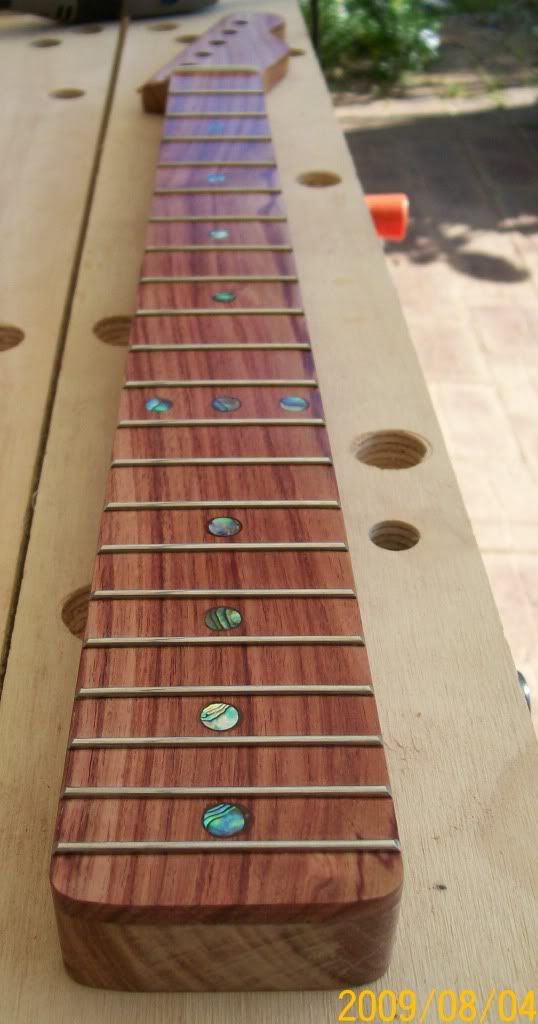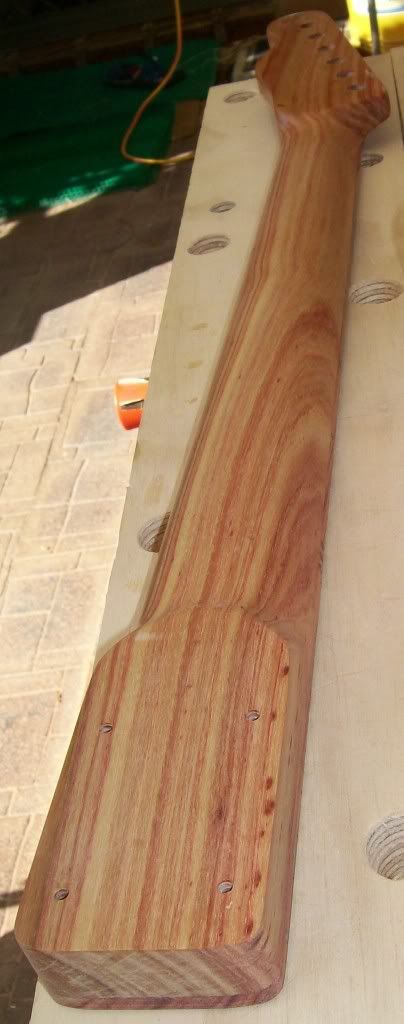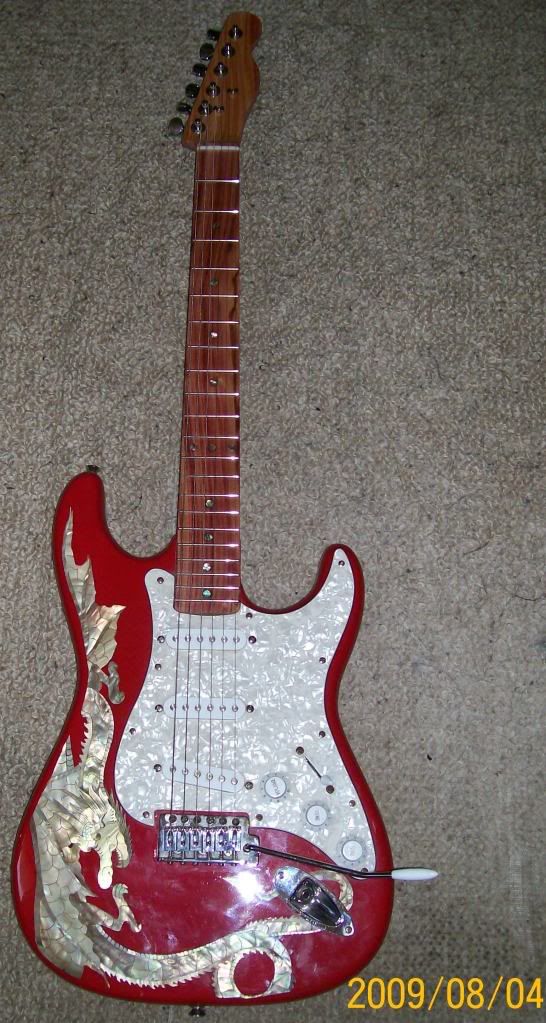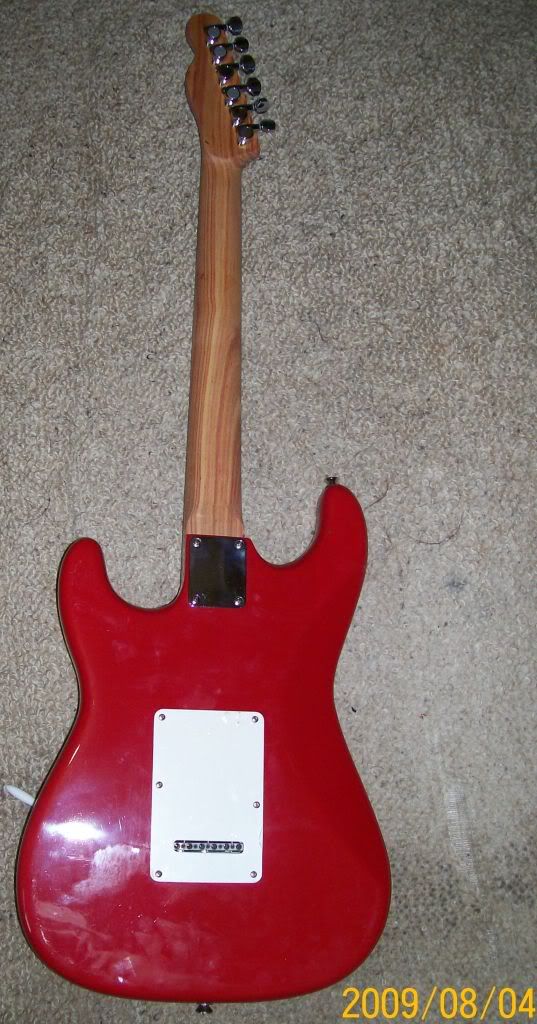 Thanks: 0
Thanks: 0
 Likes: 0
Likes: 0
 Needs Pictures: 0
Needs Pictures: 0
 Picture(s) thanks: 0
Picture(s) thanks: 0
Results 1 to 15 of 17
-
4th August 2009, 08:14 PM #1
 Apprentice
Apprentice











- Join Date
- Apr 2008
- Location
- Perth Aus
- Posts
- 577
 Brazil Tulip (tulipwood) electric guitar neck experiment
Brazil Tulip (tulipwood) electric guitar neck experiment
we've just had a wonderful spell of beautiful weather in Perth and i have taken the opportunity to not only fix up me old workmate (rotting ply boards) but also make a lil experimental neck



guess what the experiment is all about ?
will be building a body for this neck but in meantime i chucked it on one of me other guitars
really can't wait to play it
just finished it

 Looking for
Looking for
1. fiddleback mulga - 1" thick, 3"wide, 26" long
PM if you have for sale!
-
4th August 2009 08:14 PM # ADSGoogle Adsense Advertisement
- Join Date
- Always
- Location
- Advertising world
- Posts
- Many
-
4th August 2009, 08:35 PM #2
 Retired
Retired











- Join Date
- Oct 2005
- Location
- Bagdad Tasmania
- Age
- 77
- Posts
- 1,504
 Electric Guitar Neck Experiment
Electric Guitar Neck Experiment
I note the neck is not on the quarter, but it looks nice, good piece of timber.
Cheers Bob
-
5th August 2009, 01:53 AM #3

i love it!

-
5th August 2009, 02:13 AM #4
 Apprentice
Apprentice











- Join Date
- Apr 2008
- Location
- Perth Aus
- Posts
- 577

cheers Andrew
cheers BobLooking for
1. fiddleback mulga - 1" thick, 3"wide, 26" long
PM if you have for sale!
-
5th August 2009, 02:23 AM #5

i was just admiring the grain again and well.... theres no truss rod....
is that the experiment?
fretboard looks flat?
-
5th August 2009, 02:35 AM #6
 Apprentice
Apprentice











- Join Date
- Apr 2008
- Location
- Perth Aus
- Posts
- 577

first one to spot it Andrew!! nice one ....heh
and yes fretboard is zero radius but tht is not the experiment Looking for
Looking for
1. fiddleback mulga - 1" thick, 3"wide, 26" long
PM if you have for sale!
-
5th August 2009, 03:09 AM #7

yay i win

so theres nothing in there?
no steel rods, no carbon rods? nothing...
how does the no radius board play?
i was considering using one on my 7 string (because i dont have any radius blocks yet)
-
5th August 2009, 09:53 AM #8
 Senior Member
Senior Member











- Join Date
- Apr 2008
- Location
- Wollongong, NSW
- Age
- 56
- Posts
- 178

How comfortable ( or uncomfortable) is it to play with no radius ? I imagine you can set the action quite low like that...
-
5th August 2009, 11:20 AM #9
 Apprentice
Apprentice











- Join Date
- Apr 2008
- Location
- Perth Aus
- Posts
- 577

Andrew: tht is correct...nothing inside the wood of neck itself ...no truss rod...no carbon rods...
i did the coco neck with no radius and it was a bit of adjustment at first when playing ....but if you have ever played classical guitar then it should not be much of an adjustment at all
the main reason for 0 radius for me is tht when i bend on any string in any spot ..there is NO chance of fretting out and the action can be set quite low though i like a bit of 'air' between strings and fretboard
the other thing is it helps slide playingLooking for
1. fiddleback mulga - 1" thick, 3"wide, 26" long
PM if you have for sale!
-
5th August 2009, 09:40 PM #10

Interesting experiment R3R
I've always thought people go for no radius on electrics due to laziness, but I guess not always the case.
Fret outs only really occur on the tighter radiusses like 7.25" and 9.5" and less on 12" and up unless you're going all out .
I'd always go back to a good compound radius if you're worried about fretting out, plus youget the added bonus of comfortable chordal work around the nut and a flatter profile higher up in solo territory. 7.25 to 12" works nicely.
Anyway experiment away !!!
The tulip wood really looks like great stuff visuallly.
A bit like Rainbow Blackwood.
-
5th August 2009, 09:57 PM #11
 Apprentice
Apprentice











- Join Date
- Apr 2008
- Location
- Perth Aus
- Posts
- 577

i do not underestimate the power of laziness

nor deny it is a factor at work ...though there is a secondary reason why omission of steps in the building process might be a good idea...
less things to go wrong for example
and the KISS principle
but nevertheless...zero radius fretboard has its merits ...all outlined already
to me ...the fact tht radiused fretboards are a standard (espc the tighter radii ..since the problems are obvious) is somewht amusing and shows more the adherence to tradition more than anything else in this particular field...but i digress form the real experiment at hand heh
and yes...thanks for the compliments on the tulip
it is indeed a most wonderful wood but a b*&^%$ to work
if ya ever have to work it ...try not to look at it too hard or it will splinter at the edges ...and dunt force anything into holes ...like tuners and wht not ....
...and dunt force anything into holes ...like tuners and wht not ....
it is also extremely hard ....i dunt fancy handcarving(i used the woodcarver on me angle grinder) this wood for example
but the end result is super cos it can get to a glass like polish without any finish (sanding to highest grits possible...there is also no finish on this neck but i did use ultrashine to further polish the headstock front and back...tht is why it is a tad darker in appearance) with a sheen tht is quite remarkable
texture ...super fine and smooth ....sanding dust is like fine talcum powder....most pleasing to the touchLooking for
1. fiddleback mulga - 1" thick, 3"wide, 26" long
PM if you have for sale!
-
6th August 2009, 11:40 PM #12
 Senior Member
Senior Member











- Join Date
- Sep 2007
- Location
- Sydney
- Posts
- 489

Hey R3R,
Nice looking neck. What was the reason for the glued on fretboard if there is no truss rod? Is there another experiment going on there? How heavy is the tulip wood?
Cheers,
Peter
-
6th August 2009, 11:47 PM #13
 Apprentice
Apprentice











- Join Date
- Apr 2008
- Location
- Perth Aus
- Posts
- 577

thanks Peter
the tulip i got were mostly 3/4" thick ...
thus a fretboard was required to make up the 1" thickness required
the tulip neck weighed in around the same weight as the maple neck it replaced...the old maple neck had a trussrod

i prefer clean necks and the old maple neck has begun to show the telltale marks on the fretboard ...grrrLooking for
1. fiddleback mulga - 1" thick, 3"wide, 26" long
PM if you have for sale!
-
7th August 2009, 07:42 PM #14

a radius right down to 7.25" is cool for bends if you mill your frets right - i personally like the comfort factor of a tight radius and being a blues player, like to pull them strings a good tone at least - no doubt the flatter cylindrical or conical radius makes bending less reliant on a decent fret job - a flat radius makes it a no brainer
btw leo fender, the inventor of the mass produced detachable neck, used mainly flat sawn necks as he hated wasting anything - out of each stack came a few quarter sawn boards which he used along with all the flat sawn stuff
leo made his 3 prototype[s] in 1948 and the first run of esquires in 1949 1950 with no truss rod - none of these necks survive today as most were returned under warranty as they were bent - leo initially argued hotly that the necks didnt need truss rods as tjhey were thick and well dried but had to change his production methods as the necks were returned - he began using the more expensive truss rod necks around the time the broadcaster was released
correct me if i am wrong but i think it was ted mc carty at gibson who invented the truss rod
a truss rod is very helpful during setup as you can tune the relief into your neck very very accurately
hopefully your neck will survive without a truss rod - wenge as far as i know is a stable and stong timber with a lot of natural oil - if you use light strings and keep it out of envirinmental extremes you may not have a problem -
definitley a very sexy looking neck ray c
ray c
dunno what's more fun, buyin' the tools or usin' em'
-
7th August 2009, 07:49 PM #15
 Apprentice
Apprentice











- Join Date
- Apr 2008
- Location
- Perth Aus
- Posts
- 577

yes...the spirit of Leo woz wurkin through me (still)

unfortunately for Leo (who i feel was on the right track at the very start-i will make some outlandishly controversial statement soon regarding 'tone' and trussrod but a few more necks first to be sure it is not the wood talking but the design) , he used maple and the geetar pickas of them days used thick strings (equivalent to today's 12's and up with wound G string )
)
fortunately for me, i am using dalbergia ...and 10's ....
doing another dalbergia neck the same way cos the experiment surely needs a few more 'test subjects'
thnks for the compliment on the sexiness of the neck (though it is not wenge)....very smooth and silky too...wish there was some way pics can convey tht hehLooking for
1. fiddleback mulga - 1" thick, 3"wide, 26" long
PM if you have for sale!
Similar Threads
-
Electric Guitar Neck Maker Required
By CurstGuitars in forum MUSICAL INSTRUMENTSReplies: 21Last Post: 12th July 2009, 07:03 PM -
Guitar Neck and Z axis issues
By jb2060 in forum CNC MachinesReplies: 28Last Post: 9th September 2008, 11:59 PM -
CNC Guitar Neck
By jb2060 in forum MUSICAL INSTRUMENTSReplies: 11Last Post: 24th August 2008, 05:25 PM -
2 Degree guitar neck cavity
By asteam in forum MUSICAL INSTRUMENTSReplies: 4Last Post: 1st September 2007, 06:01 AM -
Tulipwood from Brazil
By PenTurner in forum WOODTURNING - PEN TURNINGReplies: 7Last Post: 14th June 2007, 04:11 PM




 Reply With Quote
Reply With Quote Cheers, Stu
Cheers, Stu 

